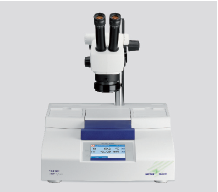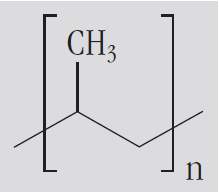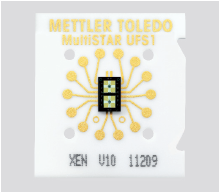Differentiation between Two Polypropylene Samples using Flash DSC
 Figure 2. The Flash DSC 1 instrument.
Figure 2. The Flash DSC 1 instrument. Figure 1. Structural formula of polypropylene.
Figure 1. Structural formula of polypropylene. Figure 3. The UFS1 sensor (UFS: ultrafast sensor) of the Flash DSC 1. Dimensions: about 2.4 by 2.4 cm.
Figure 3. The UFS1 sensor (UFS: ultrafast sensor) of the Flash DSC 1. Dimensions: about 2.4 by 2.4 cm.Polypropylene (PP), is a semicrystalline thermoplastic made by the polymerization of propane using a metal catalyst. This can result in isotactic PP (methyl groups lie on the same side of the carbon chain), syndiotactic PP (methyl groups alternate above and below the carbon chain) or atactic PP (methyl groups are randomly arranged). Isotactic PP is characterized by high crystalline content while atactic PP is more amorphous. The crystallites in isotactic PP can also be larger. In this study, two samples of polypropylene were compared that had been produced under different process conditions. The measurements were performed using DSC and Flash DSC [1]. The two polypropylene samples were supplied as granules. Both samples were unfilled.
Introduction
The structural formula of polypropylene is shown in Figure 1. Polypropylene is widely used as packaging material, as a basic material for a variety of consumer goods, for textiles, in the automobile industry, for medicinal technical products or for pipes.
To guarantee continued constant quality, we wanted to find out how the two different production methods influence the polypropylene samples and whether the products differed in their thermal properties. It turned out that the mechanical properties of the final products were in fact different.
The two different types of polypropylene were supplied as granules with a diameter of about 3 mm. The thermal properties of the materials were investigated in DSC experiments.
Flash DSC
The Flash DSC 1 instrument [1] allows the use of extremely high heating and cooling rates and is ideal for the investigation of metastable structures. The sample size used is typically 20 ng to 1 ug.
The samples are placed directly on a MEMS (micro-electro-mechanical systems) based sensor using a microscope and not in crucibles as in conventional DSC. Figure 2 shows a view of the Flash DSC 1 instrument and Figure 3 the sensor.
Experimental detailsDSC measurements
The two polypropylene samples were investigated using a DSC 1 equipped with an FRS5 sensor (FRS: full range sensor) and an IntraCooler. The results were evaluated using the...
Download the full text of this article below.
Conclusions
Two samples of polypropylene produced by different processes were investigated by DSC and Flash DSC. The final products exhibited different mechanical properties. No significant differences were detected in the crystallization and melting behavior using conventional DSC.
In contrast, Flash DSC measurements allowed the two materials to be clearly distinguished. Differences were observed in the crystallization behavior in cooling measurements and in the first heating runs of the original samples.
Differentiation between Two Polypropylene Samples using Flash DSC | Thermal Analysis Application No. UC382 | Application published in METTLER TOLEDO Thermal Analysis UserCom 38